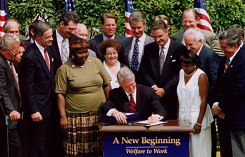- Published on
Historical Background of Welfare Reform Act of 1996
The Welfare Reform Act of 1996, known in Congress as the Personal Responsibility and Work Opportunity Reconciliation Act (PRWORA), is a bill aimed at substantially reconstructing the welfare system. It replaced Aid to Families with Dependent Children (AFDC) with Temporary Assistance to Needy Families (TANF).

The Welfare Reform Act of 1996 was designed to place time limits on government assistance, and required participants to engage in welfare-to-work activities. The Living Wage Coalition calls this legislation “welfare deform”, reminding people that the bill does fulfill President Bill Clinton’s promise of “transforming welfare as we know it.” The worst of the welfare-to-work activities necessary to qualify for a monthly grant is “workfare” – menial and degrading work like picking up trash in streets and parks. Cities and counties have used the “no wage” labor of welfare-to-work participants to replace family-supporting public sector jobs. While participants receive little to no compensation for their labor, for-profit businesses reap the subsidies.
Criticism of the Personal Responsibility and Work Opportunity Reconciliation Act
Professor of political science and social activist Frances Fox Piven believed that the problems with the welfare system stemmed from low-wage work. “After all, if there were jobs that paid living wages,” Piven said, “and if health care and child care were available, a great many women on AFDC would leap at the chance of a better income and a little social respect.”
AFDC is the only program from the 1935 Social Security Act to ever have been repealed. In response to the passage of the PRWORA, three assistant secretaries at the Department of Health and Human Services resigned in protest. Peter B. Edelman, one of the resignees, claimed that the bill increased poverty. He stated that it lowered income for single mothers, put people from welfare into homeless shelters, and left states free to eliminate welfare entirely.
